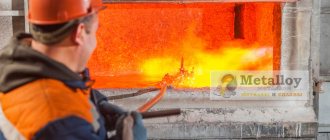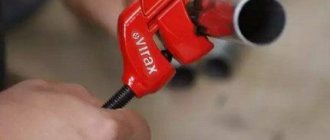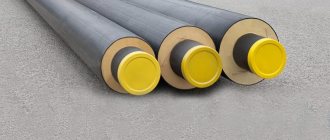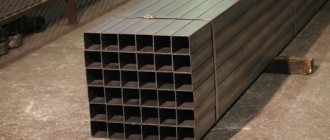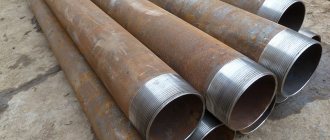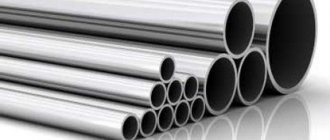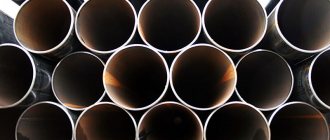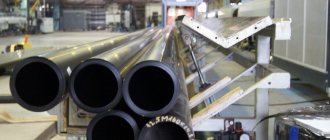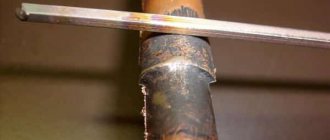Aluminum pipes have good technical and operational characteristics. They make it possible to use products made of aluminum alloys in construction, mechanical engineering, aviation and the automotive industry.
Aluminum pipes are widely used in construction fields
Aluminum pipe is lightweight, and therefore structures made from it are more profitable from a material point of view in comparison with traditional steel ones. Aluminum pipes are produced in accordance with GOST 18482-79, GOST 18475-82, GOST 23697-79 from aluminum and its alloys.
Properties and characteristics of aluminum pipes
The positive physical and chemical characteristics of non-ferrous rolled products made from pure aluminum or its alloys include the following: corrosion resistance, low weight, excellent weldability.
Aluminum products have low strength, but this disadvantage is compensated by the high ductility of the metal. It makes it possible to produce complex engineering structures.
In addition, aluminum does not change its physical and chemical properties when exposed to negative temperatures, which makes it indispensable in the manufacture of cooling climate control equipment.
The advantages of rolled aluminum products, which make it widely in demand in the metal market:
— long service life;
— wide operating temperature range from -80ºC to 120ºC;
— anti-corrosion qualities, immunity to aggressive environments;
— ability to deform without changing the basic properties at the point of deformation;
— environmental friendliness and hygiene of products;
— high coefficient of thermal conductivity (bimetallic radiators are made of metal).
Some of the above properties can be described in more detail.
1. Light weight. Allows you to significantly reduce the weight of the entire structure as a whole.
2. Good weldability properties. Aluminum pipes can be spot welded, using rollers or argon-arc welding. In this case, the corrosion characteristics of the seam do not differ from the general characteristics of the main product.
3. High anti-corrosion resistance. A natural oxide layer forms on the surface of the metal, which prevents corrosion. This oxide film is much stronger than the one that forms, for example, on the surface of iron. After mechanical stress, the oxide film is quickly restored. The same properties are preserved when the metal is in a stressed state.
Rolled aluminum pipes are sorted according to the method of technological processing and the thickness of the finished product.
Based on thickness, aluminum pipes are divided into thick-walled (thickness from 5 mm) and thin-walled (thickness up to 5 mm).
And according to the method of technological processing they distinguish:
— cold-hardened;
- semi-hardened;
— hardened;
- aged naturally and artificially.
Aluminum pipes have increased flexibility. Therefore, already at a temperature of about 20ºC, products can be easily deformed and the stability of the structure can be impaired. To eliminate this drawback and improve technological qualities, they are subjected to annealing and hardening (heat treatment) and cold hardening (mechanical processing).
Hardening (hardening) is a technological process of strengthening thermally untreated rolled aluminum at a temperature lower than the recrystallization temperature of aluminum. With the help of heat treatment and cold hardening, the physical properties of the metal change. From soft and plastic, it becomes hard and durable.
The technology described above makes it possible to produce structures and structures that can be used for a long time, since they are practically not exposed to the environment.
Disadvantages of aluminum products
In addition to the advantages, aluminum pipes have some disadvantages:
Presence of carcinogenic properties. As a result of research, it was determined that aluminum, with prolonged exposure to the human body, can lead to the occurrence of malignant tumors. Therefore, recently they began to remove aluminum pipes from the construction of pipelines that are responsible for supplying water.
This problem can be solved using various impurities. Of course, as a result, this will reduce the performance properties of the products. Negative impact of low temperatures. When exposed to low temperatures, the surface of the pipes may become deformed.
Therefore, laying a pipeline in the ground must be approached very carefully. Utility lines must be located below the ground freezing level. If this is not possible, then experts recommend using an additional thermal insulation layer.
Of course, aluminum pipes have few disadvantages, especially when compared with the advantages. But you shouldn’t forget about them when choosing products. This especially applies to the scope of their application and the features of pipeline laying.
Aluminum profile pipe
A profile aluminum pipe is a rectangle (PR), square (KV), of a certain size and thickness. Sometimes the section can be shaped (FS). Profiles are in demand for the manufacture of various structures, which are distinguished by strength and lightness. List of industries for application of profiled aluminum pipes - agriculture, industry, construction. Separately, we can highlight the architecture and design of the premises. Here, aluminum rolled metal is popular because of its attractive appearance, lightness, strength, and corrosion resistance.
Profile pipes, unlike round ones, have a number of advantages:
— by reducing metal consumption, the weight of the overall structure is reduced;
— profile rolled products are more convenient to store and transport;
— the structure is more rigid and can withstand heavy loads;
— often a rectangular or square pipe is needed for the construction of some elements.
Installation of profile pipes is carried out in two ways:
— using special fittings presented in a wide range;
- using welding.
An aluminum pipe can have a cross-section as follows:
- square (KV). In this case, the strength of the structure is determined by symmetrical stiffeners;
- rectangle (PR). It is used for uneven loads, when it is necessary to strengthen one side;
- shaped (FS). It is used in certain cases when there is a need to use a pipe of this particular cross-section.
Profile aluminum products are used for laying communications both inside and outside a building or structure. Such communications are durable, light, strong. The use of just such a profile affects the price of the finished product - it reduces the cost of the entire structure as a whole.
According to the production method, profile pipes are divided into:
1. Pressed. Manufacturing using a press.
2. Cold-formed. Here the workpiece is an aluminum circle, and manufacturing consists of successive operations of drawing, piercing and calibration.
3. Welded. Electric welding of aluminum sheets is used. The final product is a profile in the form of a square or rectangle. Then a hot tempering operation is performed. It is used to neutralize internal stresses in welds.
There are no joints or seams on the rolled surface. This makes the distribution of loads uniform across the edges of a rectangle or square. Therefore, even a small square pipe with a side of 2 centimeters can withstand significant loads. Among profiled products, the most commonly used aluminum tube is 40*40 (i.e., with a side of 40 mm). It is necessary for the installation of various structures in many industries.
Features of application for air conditioning systems
Copper is considered the traditional material for the production of air conditioner tubes, and for many consumers it may be a discovery that there is an alternative in the form of aluminum. Aluminum is approximately 2 times cheaper than copper; its use can significantly reduce the cost of connecting air conditioners. Why do many professionals still avoid using aluminum pipes for air conditioners?
Aluminum pipe after the necessary processing is used for air conditioners
The fact is that copper and aluminum react and corrosion occurs, which does not allow the use of aluminum products. However, modern technological solutions make it possible to cope with this problem. Aluminum tubes for air conditioners with copper tips have now become available for purchase. During their production, pieces of copper are welded to an aluminum tube using modern high-tech equipment using the intermolecular welding method.
The result is a reliable material for installing air conditioners at minimal cost. The attitude towards aluminum tubes for air conditioners is still quite skeptical, but users who decided to try them note the quality and significant savings.
Aluminum pipe sizes
The following types are distinguished:
- thin-walled. Wall thickness up to 5 mm. This type of product is produced by most manufacturers of pipe products;
- thick-walled. Wall thickness from 5 mm.
GOST 18475-82, GOST 18482-79, GOST 23697-79 present the overall dimensions and theoretical (calculated) weight of 1 meter of pipe with a given wall thickness.
The range of cold-deformed aluminum pipes in accordance with GOST 18475-82 can be seen in the table, which shows the dimensions for finished rolled pipe profiles.
Outer diameter (D) - from 6 to 120 mm, wall thickness (S) - from 0.5 to 5 mm, weight of one meter - from 0.023 kg to 4.948 kg.
GOST 18475-82 also specifies the overall dimensions and weight of 1 meter of rolled pipes of rectangular and square cross-section, and round rolled products with an outer diameter of 130 to 150 mm.
The final product according to GOST 18475-82 can be of measured length or unmeasured. As a rule, for pipes of small diameter and thickness, the length varies from 1 to 6 m, and for larger diameters it should not exceed 4 m.
The range of extruded pipes made of aluminum and alloys in accordance with GOST 18482-79 can be seen in the table, which shows the dimensions of rolled pipes with a round section.
Outer diameter (D) - from 18 to 300 mm, wall (S) - from 1.5 to 40 mm, weight of one meter - from 0.222 to 93.116 kg.
The length of finished products in accordance with GOST 18482-79 can be unmeasured, measured, or a multiple of the measure, supplied in lengths. Usually it varies from 1 to 6 meters.
In addition, GOST 18482-79 contains sizing tables for pipes made from various aluminum alloys.
Some recommendations from professionals
When doing the work yourself, decide in advance about the need to use these products. Otherwise, there will be a significant financial overrun, since a cheaper material may be suitable to create a structure of the same strength.
To solder or weld aluminum profile pipes, the performer must have the appropriate skills. Therefore, carrying out such work can cause certain difficulties. If a large span is created, it is necessary to install additional stiffeners.
Despite the fairly high cost of profile aluminum pipes, these products occupy a large niche in the corresponding segment of the construction market.
Aluminum pipe production
According to the manufacturing method, rolled aluminum pipes are divided into three main types:
— aluminum pipes produced by pressing;
— manufactured according to the principle of stainless steel pipes, i.e. welding of a strip (tape) or sheet in combination with a hot tempering operation. It helps relieve internal stress on welding seams;
- made by cold deformation of a circle. The technology includes drawing, flashing and calibration.
In modern conditions, all types of production make it possible to obtain economical and high-quality products.
To produce a round aluminum pipe in accordance with GOST 22233-2001, non-ferrous metal marked A5, AD1, A8, AD, A85, alloys marked AMts, AMtsS, AMg1, AB, AD31, D1 are used.
The manufacturing technology includes several successive stages. First, the workpiece is heated, then pressed on the die of a rolling mill to obtain a circle shape. Then - pressing with a stamp in order to obtain an internal hole. Then a hardening operation is carried out. The last stage is carried out depending on the wishes of the customer. This is the application of an anodic coating to the surface of the finished product to thicken the natural protective layer.
Longitudinal welded pipes are made from tape. Aluminum alloys AMg2, VD1, AMg3, AMg5, D1, D16, AK6 are taken as the starting material.
The production technology is a continuous process of welding with high frequency current. The outer diameter, according to the assortment according to GOST 23697-79 (on straight-seam welded pipes made of aluminum alloys), varies from 10 mm to 220 mm.
Seamless cold-deformed pipes are made from metal alloys of the AMg2, D16, AMg3, AMg5, AMg6 grades.
Manufacturing method: drawing and calibrating rounded semi-finished products at low temperatures. The finished pipe product is used in many industries.
Based on the quality requirements for the final product, the surface must be smooth and even. The surface and sections must not contain defects such as:
- burrs, roughness;
— pockets of corrosion;
— traces of looseness, signs of burnout;
- cracks, cavities, chips, delaminations.
The following are not considered defects:
— dents that do not exceed the permissible deviations from the diameter;
— pressings, scratches that do not affect the minimum permissible diameter of the finished product;
- spots, stripes in the form of rings and spirals;
- residual material for lubrication.
Varieties
Depending on certain characteristics, aluminum pipes are divided into several types. Depending on their purpose and shape, products can be round or shaped. If the wall thickness is no more than 5 mm, then these pipes are considered thin-walled, and if the wall is thicker than 5 mm, they are considered thick-walled. Metal processing technology determines the following types of pipes:
- without heat treatment (no designation);
- annealed (marked with the letter “M”);
- hardened and naturally aged (designated as “T1”);
- hardened and artificially aged (o).
The manufacturing method affects the strength and other parameters of aluminum pipes, which may determine their scope of application.
